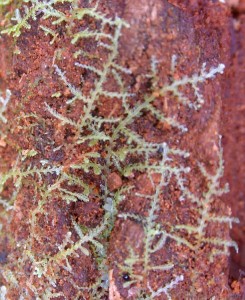Jungermanniidae is commonly referred to as the “Leafy Liverworts”. The group is diverse, composed of nearly 4000 to 6000 species. Leafy liverworts are abundant in temperate, subtropical, and tropical regions. Leafy liverworts may grow on a diverse array of substrates. Jungermanniidae shoots are typically well-branched and form mats across the substratum, including the leaves of other tracheophytes and tree bark.
The name “Leafy Liverworts” refers to a unifying characterisitic of this group. The leaves of the gametophytic generation are arranged in two flattened lateral rows, with leaves that are equal in size. A third ventral row of leaves may or may not be present, these leaves are typically referred to as the underleaves. Lateral and underleaves are unistratose, composed of undifferentiated cells, generally do not contain a midrib, and may or may not be lobed.
 The sexual reproductive structures are located on the short and lateral side branches of shoots. Archegonia are located within a modified leaf known as a perianth. The sporophytic generation will develop within the perianth, and when the conditions are appropriate for spore dispersal, the seta will elongate to elevate the mature sporangium.
The sexual reproductive structures are located on the short and lateral side branches of shoots. Archegonia are located within a modified leaf known as a perianth. The sporophytic generation will develop within the perianth, and when the conditions are appropriate for spore dispersal, the seta will elongate to elevate the mature sporangium.
Jungermanniales:
Bazzania denudata
Calypogeia azurea
Calypogeia muelleriana
Cephalozia bicuspidata
Gyrothyra underwoodiana
Herbertus aduncus
Lepidozia reptans
Lophocolea cuspidata
Plagiochila porelloides
Scapania bolanderi
Tritomaria quinquedentata
Porellales:
Frullania franciscana
Porella navicularis
Porella cordaeana
Radula complanata
Ptilidiales:
Ptilidium californicum

